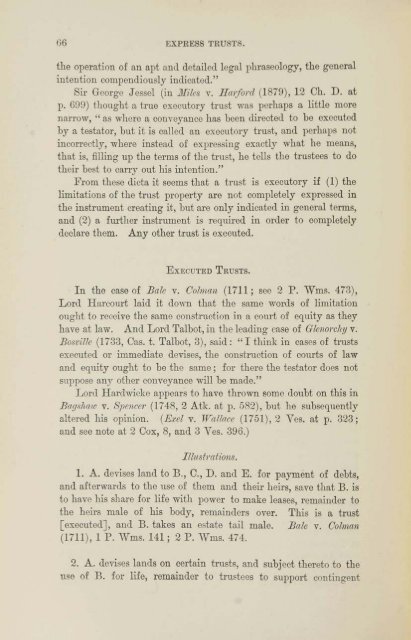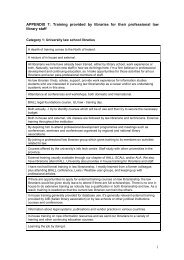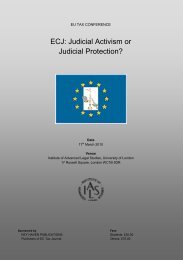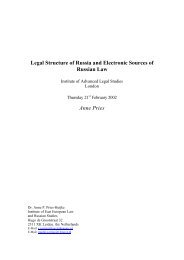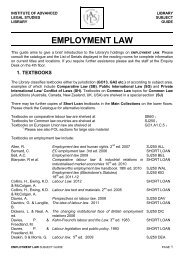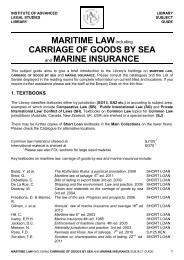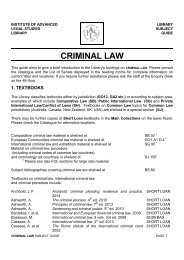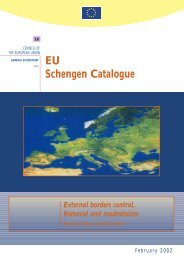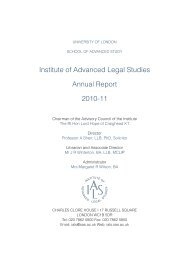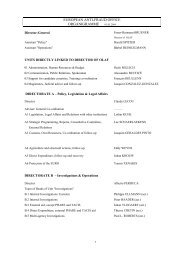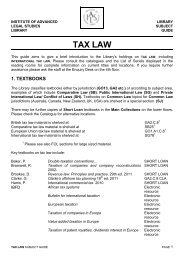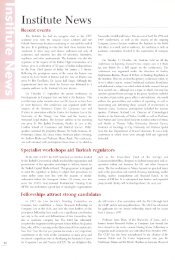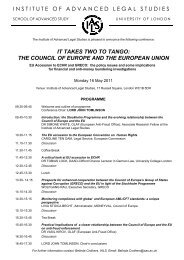a thesis - Institute of Advanced Legal Studies
a thesis - Institute of Advanced Legal Studies
a thesis - Institute of Advanced Legal Studies
Create successful ePaper yourself
Turn your PDF publications into a flip-book with our unique Google optimized e-Paper software.
66 EXPRESS TRUSTS.<br />
the operation <strong>of</strong> an apt and detailed legal phraseology, the general<br />
intention compendiously indicated."<br />
Sir George Jessel (in Miles v. Ilarford (1879), 12 Ch. D. at<br />
p. 699) thought a true executory trust was perhaps a little more<br />
narrow, " as where a conveyance has been directed to be executed<br />
by a testator, but it is called an executory trust, and perhaps not<br />
incorrectly, where instead <strong>of</strong> expressing exactly what he means,<br />
that is, filling up the terms <strong>of</strong> the trust, he tells the trustees to do<br />
their best to carry out his intention."<br />
From these dicta it seems that a trust is executory if (1) the<br />
limitations <strong>of</strong> the trust property are not completely expressed in<br />
the instrument creating it, but are only indicated in general terms,<br />
and (2) a further instrument is required in order to completely<br />
declare them. Any other trust is executed.<br />
EXECUTED TRUSTS.<br />
In the case <strong>of</strong> Sale v. Column (1711; see 2 P. Wms. 473),<br />
Lord Harcourt laid it down that the same words <strong>of</strong> limitation<br />
ought to receive the same construction in a court <strong>of</strong> equity as they<br />
have at law. And Lord Talbot, in the leading case <strong>of</strong> Gknorchy v.<br />
Bosville (1733, Gas. t. Talbot, 3), said: " I think in cases <strong>of</strong> trusts<br />
executed or immediate devises, the construction <strong>of</strong> courts <strong>of</strong> law<br />
and equity ought to be the same; for there the testator does not<br />
suppose any other conveyance will be made."<br />
Lord Hardwicke appears to have thrown some doubt on this in<br />
Bagshaw v. Spencer (1748, 2 Atk. at p. 582), but he subsequently<br />
altered his opinion. (Exel v. Wallace (1751), 2 Ves. at p. 323;<br />
and see note at 2 Cox, 8, and 3 Ves. 396.)<br />
Illustrations.<br />
1. A. devises land to B., C., D. and E. for payment <strong>of</strong> debts,<br />
and afterwards to the use <strong>of</strong> them and their heirs, save that B. is<br />
to have his share for life with power to make leases, remainder to<br />
the heirs male <strong>of</strong> his body, remainders over. This is a trust<br />
[executed], and B. takes an estate tail male. Sale v. Colman<br />
(1711), 1 P. Wms. 141; 2 P. Wms. 474.<br />
2. A. devises lands on certain trusts, and subject thereto to the<br />
use <strong>of</strong> B. for life, remainder to trustees to support contingent


